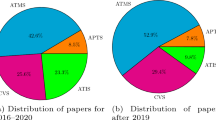Abstract
This paper presents the definition of the collective utility of groups of entities called ensembles that come into a collaboration to accomplish their individual goals. We propose an analytic method for assessing the utility of an ensemble taking into account the entities preferences. We use this model to build a hierarchy of utilities that corresponds to the ensembles hierarchical structure and compute high level utilities incorporating lower level utilities. We apply this model to various scenarios of an urban mobility system, providing examples of utility functions in all levels. We formulate an optimization problem to allocate passengers in bus routes effectively and perform experiments to compare our approach with the optimal allocation of passengers in terms of collective utility.







Similar content being viewed by others
References
Andrikopoulos V, Bucchiarone A, Gómez Sáez S, Karastoyanova D, Antares Mezzina C (2013) Towards modelling and execution of collective adaptive systems. In: 9th international workshop on engineering service-oriented applications (WESOA 2013), in conjunction with ICSOC 2013, Berlin, Germany
Bitsaki M, Stamoulis GD, Courcoubetis C (2006) An efficient auction-based mechanism for hierarchically structured bandwidth markets. Comput Commun 29:911–921
Maillé P, Tuffin B (2004) Pricing the internet with multi-bid auctions, Irisa, Rennes, Technical Report 5235
Iosifidis G, Chorppath AK, Alpcan T, Koutsopoulos I (2012) Incentive mechanisms for hierarchical spectrum markets, in NetGCoop, Avignon
Foster ST, LaCava G (2007) The analytical hierarchy process: a step-by-step approach. https://acc.dau.mil/CommunityBrowser.aspx
Saaty TL (1980) The analytic hierarchy process. McGraw-Hil, New York
Keeney RL, Raiffa H (1976) Decisions with multiple objectives: preference and value tradeoffs. Wiley, New York
Weiss JW, Weiss DJ, Edwards W (2010) A descriptive multi attribute utility model for everyday decisions. Theory Decis 68(1–2):101–114
Bayus B, Rao V (1989) A hierarchical utility model for the dynamic acquisition of hetero-geneous items. Market Lett 1:71–80
Jimenez A, Rios-Insua S, Mateos A (2003) A decision support system fo rmultiatttribute utility evaluation based on imprecise assignments. Decis Support Syst 36:65–79
Bucchiarone A, Marconi A, Raik H (2015) Theory and tools for ensemble re-configuration and evolution. Deliverable 3.2, ALLOW Ensembles project
Acknowledgments
This work was funded by the FP7 EU-FET project 600792 ALLOW Ensembles.
Author information
Authors and Affiliations
Corresponding author
Rights and permissions
About this article
Cite this article
Bitsaki, M., Dramitinos, M., Koutras, G. et al. Collective utility in hierarchical structures of collective adaptive systems: an application in transportation systems. Comput Sci Res Dev 32, 343–352 (2017). https://doi.org/10.1007/s00450-016-0339-y
Published:
Issue Date:
DOI: https://doi.org/10.1007/s00450-016-0339-y




